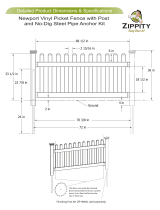
Model T31634/T31635 (Mfd. Since 8/19)
-13-
Additional Safety for Miter Saws
CHANGING BLADES. Accidental startup while
changing saw blade can result in serious injury.
Always disconnect power before changing blades
and wear gloves to protect hands. Do not use
blades with different diameters or arbor hole
shapes/sizes. Always ensure blade is oriented
with marked blade rotation direction.
BLADE ADJUSTMENTS. Adjusting blade miter
or tilt during operation increases risk of crash-
ing blade and sending metal fragments flying at
operator or bystanders. Only adjust blade when
blade is completely stopped and saw is discon-
nected from power and be sure to lock settings
and adjust fence to properly support workpiece
and clear guard and blade before operation.
SAW OPERATION. Ensure saw is placed on
level, firm work surface before use and clear all
tools, wood scraps, etc., as debris can be thrown
at high speeds. Always allow blade to reach full
speed before contacting workpiece. When cut is
finished, allow blade to completely stop before
removing from workpiece. Hold handle firmly
when making non-through cuts and when releas-
ing trigger before saw head is completely in down
position. Never pull saw through cut as this can
cause saw head to kickback toward operator.
Always push toward the fence for sliding cuts.
BLADE GUARD. Make sure blade guard is
installed, working correctly, and used for all cuts.
Promptly repair or replace if damaged. Re-install
immediately after servicing saw blade.
JAMMED OR CUT-OFF PIECES. To avoid risk
of injury due to blade contact, turn saw OFF and
allow blade to completely stop before removing
cut-off pieces. Unplug saw before working to free
jammed pieces. Never use your hands to move
cut-off pieces away from blade while saw is run-
ning. Do not use stop blocks that may wedge cut-
off pieces against saw blade.
Serious cuts, amputation, or death can occur from contact with rotating saw blade during
operation. Workpieces, broken blades, or flying particles thrown by blade can blind or strike
operators or bystanders with deadly force. To reduce the risk of these hazards, operator and
bystanders MUST completely heed the hazards and warnings below.
HAND & BODY POSITIONING. Keep hands at
least 4" away from spinning saw blade and out
of blade path when cutting. Only operate at front
of machine. Never reach behind or around blade
and never support the workpiece cross handed.
Do not place saw on floor and work over top of it.
WORKPIECE SUPPORT. To maintain maximum
control and reduce risk of blade contact from bind-
ing or kickback, always ensure stable, adequate
support for long/large workpieces. Always keep
workpiece stationary, flat, and firmly held against
table/fence when cutting to avoid loss of control.
Secure workpieces with clamps whenever possi-
ble. Only cut one workpiece at a time—do not cut
stacks. Warped material may cause binding so it
must be clamped with outside bowed face toward
fence so there is no gap between workpiece,
fence, and table along line of cut.
DULL/DAMAGED SAW BLADES. Dull blades
require more effort to perform cuts. Broken saw
blade teeth can become deadly projectiles. Do
not operate with damaged, cracked, or badly worn
blades. Inspect for damage before each use.
CUTTING CORRECT MATERIAL. Never cut fer-
rous materials as they increase risk of operator
injury and can produce sparks or flying particles
that may jam. Only cut natural and man-made
wood products, laminate-covered wood products,
and some plastics. Inspect workpiece for warping
or embedded materials like nails or other foreign
objects before cutting.
SMALL WORKPIECES. If hands slip during
cut while holding small workpieces with fingers,
serious personal injury could occur. Always sup-
port small, narrow, and round workpieces with
appropriate type of clamping fixture. Do not cut
workpieces that are too small to effectively sup-
port or require hands/fingers to be closer than 4"
away from blade.
























